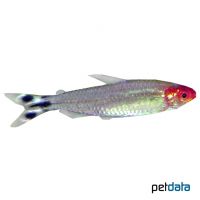Rummynose Tetra (Hemigrammus bleheri)
| Rummynose Tetra Hemigrammus bleheri | |
|---|---|
| Name | Rummynose Tetra |
| Name Lat. | Hemigrammus bleheri |
| Family | Characins |
| Family lat. | Characidae |
| Order | Characins |
| Order lat. | Characiformes |
| Origin | Brazil, Colombia |
| Habitat | Rivers |
| Diet | Omnivore |
| pH | 5.5-7.0 |
| Behavior | Peaceful |
| Keeping | Swarm |
| Care Level | Moderate |
| Reproduction | Egg scatterer |
| Breeding | Difficult |
| Life Span | 3-6 years |
| Protection | No |
| Metric Units | |
| Size | 4.5 cm |
| Temperature | 23-26 °C |
| Hardness | 2-15 °dH |
| Aquarium | ~ 100 l |
| US Units | |
| Size | 2" |
| Temperature | 73-79 °F |
| Hardness | 36-267 ppm |
| Aquarium | ~ 25 gal |
Distribution and habitat
The distribution area of the Red-headed Tetra is the river systems of the Rio Negro (Brazil) and the Rio Meta (Colombia). There they live in the slow-flowing, nutrient-poor blackwater rivers, which have their origin in the humic rainforests and are dark brown in color
Maintenance
The aquarium should have soft, slightly acidic water and varied planting that provides both shelter and swimming space. A dark substrate, shaded light (floating plant cover) and low current is ideal.
There should be no detectable ammonia, ammonium or nitrite, and the nitrate level should not exceed 100 mg/l. To ensure the water quality and oxygen content, a filter and heater adapted to the aquarium size is required, as well as lighting for the species-appropriate day-night rhythm of the animals.
Diet
The food offer consists of live food, such as cyclops, daphnia and tubifex, which is accepted without problems also in frozen form, supplemented with frozen food mixtures. Especially mysis and mosquito larvae should not be missing. In addition, they also need some vegetable food, such as crushed peas, mashed leafy and wild vegetables or dry food (flakes, granules) with high vegetable content (spirulina, kelp)
A regular and varied diet promotes health and increases resistance. Only feed as much as is eaten immediately (in a maximum of 10 minutes).
Behaviour and compatibility
Redhead tetras are agile peaceful schooling fish and easy to socialize with similar species. At least 10 red-headed tetras should be kept together, but preferably more.
Only mutually compatible fish species with similar requirements for water conditions and water temperature may be socialized.
Sex dimorphism
The male is more slender, the female fuller in the abdomen.
Reproduction and breeding
In soft, peat-filtered water (pH 6-6.5), with a hardness below 4 KH and at a water temperature of 27 °C, Red-headed Tetras spawn between fine-textured plants. The young hatch after 30-36 hrs and swim freely from the 4th day.
Juveniles must be fed several times a day with special rearing food (dust food). In community tanks breeding is hardly possible, because the spawn is easy prey.
Important
They are not always an easy species to maintain. Special care should be taken to keep nitrate levels as low as possible. The red-headed tetras are easily confused with Hemigrammus rhodostomus (Ahls red-headed tetra) and Petitella georgiae (Georgis red-headed tetra).
Feeding plant foods reduces the risk of the fish eating the tender shoots of aquatic plants.
The well-being of the fish should be monitored regularly. Temperature should be checked daily, pH, hardness and nitrate levels should be checked at least every 14 days. Regular partial water changes are recommended, even if the contaminant level has not yet reached the upper limit. Sudden changes in water quality should be avoided. Newly introduced fish must be accustomed slowly to the water in the aquarium.
Further literature can be found in your pet store.
References
Text: petdata; Image: petdata
Source: BMELV (1998): Tierschutzgutachten - Haltung von Zierfischen (Süßwasser); RIEHL & BAENSCH (2006): Aquarien Atlas Bd. 1, Mergus Verlag; ENGELMANN (2005): Zootierhaltung - Tiere in menschlicher Obhut: Fische, Verlag Harri Deutsch
- Gemäß § 21 Abs. 5 Tierschutzgesetz idgF
